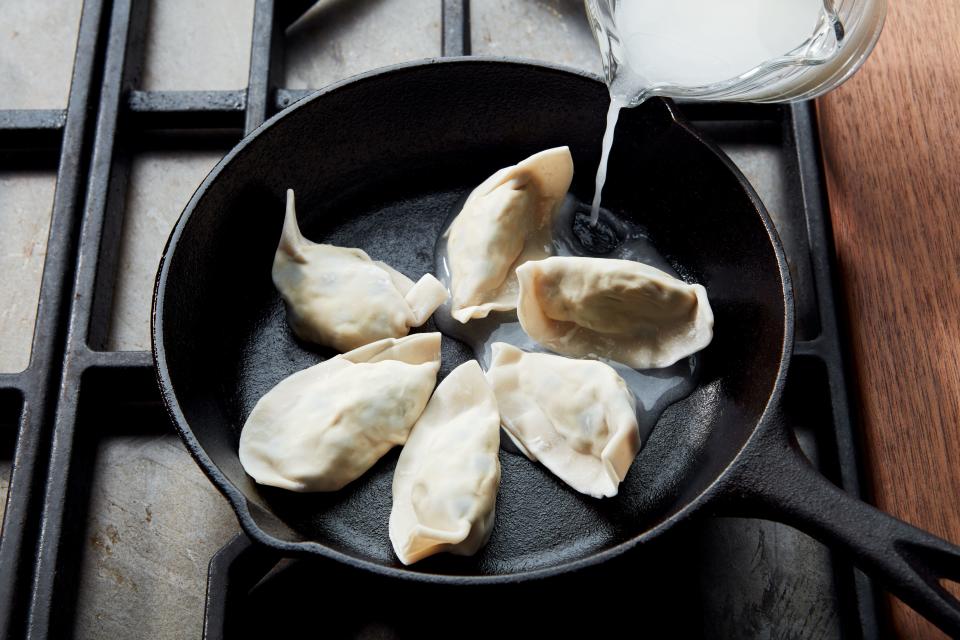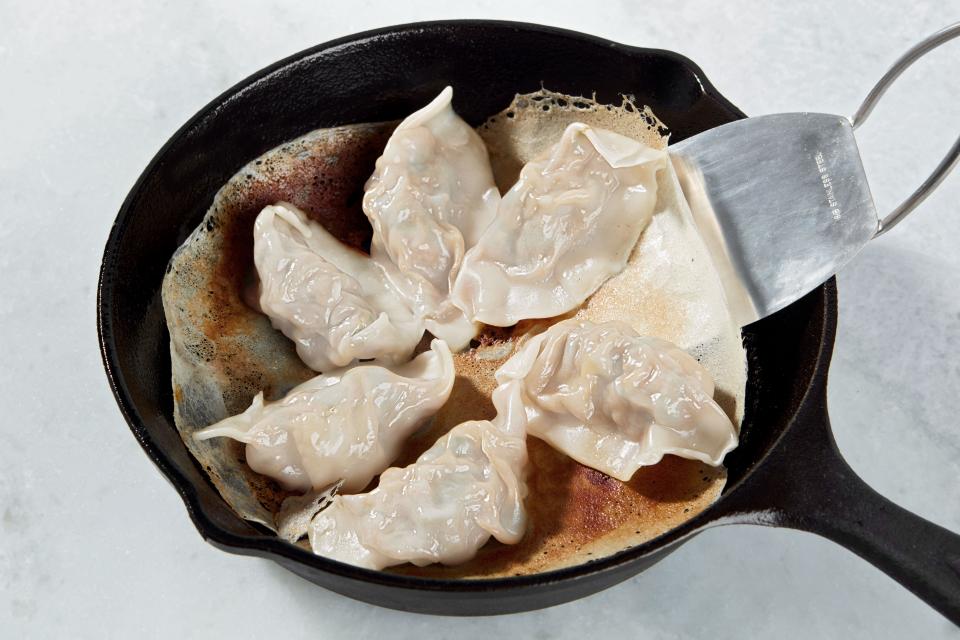Give Your Potstickers an Extra-Crispy Skirt
Have you ever eaten a potsticker and said to yourself, I wish this was less crunchy? Neither have I. But dumplings are like children; not all of them shine and caramelize beautifully when tossed into a hot pan. Fortunately, we have a solution called the dumpling skirt.
The dumpling skirt is the paper-thin sheet of crackly starch that some potsticker pros use to connect a ring of separate dumplings into a single visually impressive disk, all while adding precious square inches of pan-fried crust. Though it really shines with homemade dumplings, you can also use it to gussy up frozen ones you buy at the supermarket. It is the great dumpling equalizer.
I’ve eaten my share of dumpling skirts across China, Japan, and Taiwan, but many of my favorites come from my home of New York, specifically those made by Helen You, the chef and owner of Flushing’s Dumpling Galaxy, whose cookbook I helped write a few years ago. At her flagship restaurant, a satellite food court stall (plus a new bun shop opening soon), Helen makes over 100 kinds of dumplings, many of them outfitted with a dumpling skirt. “It’s a way to hold all the dumplings together,” she says, which is handy when turning out thousands of dumplings a day, “and everyone likes the extra crunch.” Here’s how she makes hers.
Gather your tools
Helen insists that there’s nothing better for frying dumplings than a cast iron skillet. “It won’t get too hot too fast, and won’t cool down when you put the dumplings in,” she says. An 8-inch skillet easily holds six or seven potstickers—called guo tie in Mandarin—and makes a skirt that isn’t too hard to maneuver. Beginners may find that nonstick is easier, especially if your cast iron isn’t well seasoned.
You’ll also need a glass lid that fits the skillet reasonably tightly. Glass isn’t essential, Helen tells me, but it does help you keep an eye on the dumplings while they cook, and the ones with little steam vents let out just enough moisture to help your crust form. Last, pull out your largest, thinnest, most flexible offset spatula. (I like metal, but heatproof silicone will probably work, too.) This will help you dislodge the skirt from the pan when it’s time to flip.
Prep your skirt slurry
Helen’s dumpling skirt begins with a cup of water, 2 tablespoons of all-purpose flour, and 1 tablespoon of plain distilled white vinegar, all whisked with a fork into a loose slurry. This is the cooking liquid that will steam the dumplings to cook them through. As the water evaporates in the pan, the remaining starch will set into the skirt. Helen’s not exactly sure why the vinegar works, “but I’ve learned from practice that you get a crispier crust with it,” she says.
Start frying
Set your skillet over medium-high heat and get your dumplings ready to go. If you’re using frozen dumplings, let them defrost completely before you start pan-frying, and if you made your own dumplings with storebought wrappers, make sure they’re sealed tight—the intense heat from the pan has a way of rupturing sealed edges, Helen warns. Once the pan is hot, brush or drizzle a tiny bit of oil across the surface. You don’t need a lot of fat to pan-fry dumplings, just enough to make the surface glisten. Then place your dumplings in the skillet 1 inch apart. Don’t try to move them once they hit the pan; that’s what leads to broken skins.

Crispy Dumpling Wings - PROCESS - Slurry
As soon as the dumplings start to sizzle, slowly add your slurry to completely cover the bottom of the pan. Again, you don’t need much—one third of the way up the dumplings is plenty. Then cover the pan and get ready for the hardest part: waiting.
Pan-fried dumplings take six to eight minutes to cook. During that time, Helen slowly reduces the heat, first bringing it down to medium after 2 minutes, then eventually down to low. “You need the high heat at the start to penetrate the dumplings, but it you keep it high, they’ll burn.” If the universe is smiling on you, the tops of the dumplings will cook through at about the same time that all the water in the slurry is cooked off. Once the pan is “dry,” the skirt will start to brown, and eventually it’ll loosen itself from the pan so you can shloop it out in one piece.

Crispy Dumpling Wings - PROCESS - Spatula
And be patient
I’m bringing the universe into this because, to be frank, making good guo tie isn’t easy, and it’s going to take you a few rounds to dial in your cooking times and slurry amounts. There are so many variables at play here: the BTUs of your burner, the thickness and surface area of your pan, the exact makeup of your dumplings. Every home setup is different, and even after years of practice, I still wind up with a plate of struggle dumplings now and then. When it works, though, which is most of the time, it feels like I’ve just pulled off some feat of cheffy magic that us mere mortals aren’t allowed to experience.
The key, Helen reminds me, is patience and flexibility. If your dumplings look well-cooked but there’s still a lot of slurry in the pan, boost the heat and remove the lid to speed up evaporation. If you see signs of burning, add a little more slurry to any hot spots, a tablespoon at a time. Regardless, you need to patiently wait for the dumpling skirt to set and brown before you try removing it. Check if the edges are beginning to pull away from the pan; the skirt will tell you when it’s ready to be set free.
I’ve never seen Helen make any mistakes with her guo tie, but she has 40 more years of dumpling experience than I do. Here’s what I can tell you from my (many) missteps along the road to potsticker perfection: the mistakes still taste pretty good.
Lamb and Green Squash Dumplings
Originally Appeared on Epicurious


